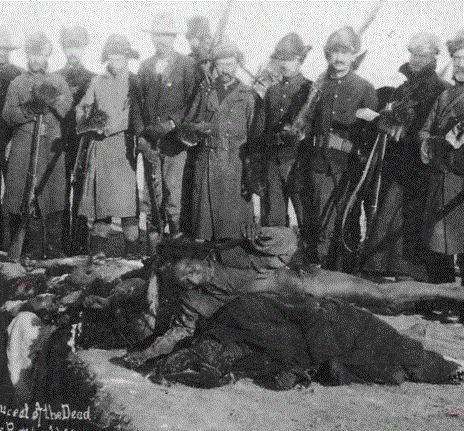Boarding School and Land Allotment Eras 1879-1933
1890
Massacre at Wounded Knee

Upon hearing about Sitting Bull’s death, Chief Big Foot decides to move his band to a more protected area of the Pine Ridge reservation for the Ghost Dance ceremony. During that time, U.S. troops patrol the plains to stop Ghost Dancers and ceremonies. On December 29, the U.S. Army’s 7th Cavalry encounter and surround Big Foot’s camp. Big Foot, ill with pneumonia, rides to the leaders of the cavalry in a wagon with a white flag of truce and surrenders to the cavalry. Big Foot and his band of warriors agree to surrender their arms the following morning in preparation for travel to the Pine Ridge agency. When troops are sent to disarm the warriors the following day, an altercation arises and a gun goes off. The 500 troops open fire with four howitzers into the center of the unarmed encampment. More than 250 women and children who have not been killed flee down ravines. U.S. soldiers hunt them down, killing more than 146 women, children, and elder men and wounding 51, leaving a trail of bodies that reportedly stretches for miles (Nies, 1996). It is estimated that over 300 Lakota, half of them women and children, are massacred. Some historians speculate that the soldiers of the 7th Cavalry deliberately take revenge for the regiment’s defeat at Little Bighorn in 1876. The massacre ends the Ghost Dance movement.
Charles Eastman writes of the massacre: “Fully three miles from the scene of the massacre we found the body of a woman completely covered with a blanket of snow, and from this point on we found them scattered along as they had been relentlessly hunted down and slaughtered, while fleeing for their lives. Some of our people discovered relatives or friends among the dead, and there was much wailing and mourning. When we reached the spot where the Indian camp had stood, among the fragments of burned tents and other belongings, we saw frozen bodies lying close together or piled one upon another…. It took all my nerve to keep my composure in the face of this spectacle, and of the grief of my Indian companions, nearly everyone of whom was crying aloud or singing his death song.” (Native Voices, “1890: Dakota doctor witnesses Wounded Knee aftermath”).